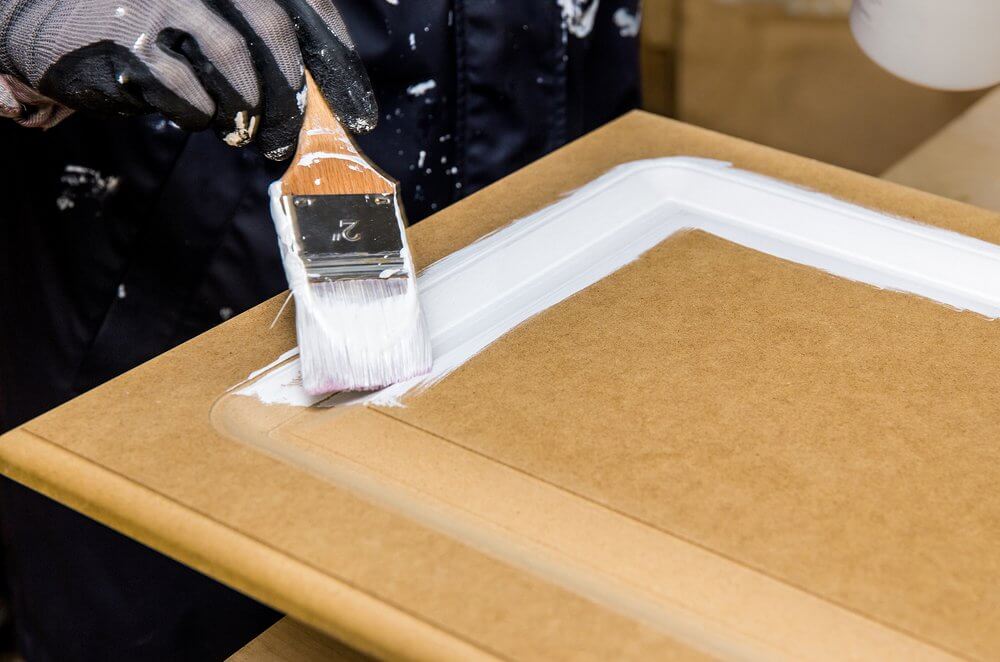Professional woodworkers and DIY enthusiasts alike often wonder the magic number when applying primer paint on cabinets.
You should aim for at least two coats of primer on cabinets. Although one coat is sometimes sufficient, two are even better as it ensures a more durable, more stain-resistant finish with fewer surface imperfections.
However, you might have heard a few people applying up to three primer coats on cabinets.
Read on to understand why primer paint is necessary in the first place and how many coats of primer on wood is ideal before painting. Keep in mind that more primer coats isn’t necessarily better; using too much will only result in additional costs and wasted time.
What’s Primer?
Primer, or paint primer, is a type of white paint used on furniture and other surfaces to make the surface more adhesive to paint. Think of it as a base coat that creates the foundation for a flawless paint job.
For one, not all cabinets are easy to paint. Paint doesn’t readily stick to them. So, without something to help the paint stick, you may struggle to paint the cabinet.
Additionally, even if the paint sticks, you should always think about how long it can last as no one enjoys repainting the same piece of furniture every few weeks. Paint primer helps in these two areas and more.
- It covers imperfections such as cracks on the wood and splintered sections.
- It conceals stains, effectively preventing future bleeding that may destroy your paint.
- It prevents wood from absorbing excessive amounts of paint during and after the paint job.
- It neutralizes the colors of the wood, allowing the final paint color to shine through. This can be vital in projects such as constructing two tone cabinets.
When Should You Use a Paint Primer?
Every time before you paint your woodworks! We strongly urge woodworkers to resist the urge to overlook paint primer. It might seem the perfect shortcut to cut costs, but it isn’t.
Painting without first applying primer often means that you need more coats of paint to provide a smooth, quality finish. More paint coats mean increased costs. Additionally, you may be left with an uneven finish that may compromise the quality of the finish and impact overall space cohesion.
For the above reasons, you should use paint primer on every cabinet-making project. We recommend using primer;
- When painting the cabinet for the first time
- When switching from a darker color to a lighter one like blue.
- Following significant cabinet repairs
How Many Coats of Primer Should You Apply on Cabinets?
Ideally, you need at least two coats of primer on cabinets and a coat of paint on top. However, this doesn’t necessarily apply to all projects. For instance, sometimes, one coat of primer might be sufficient. Yet, you may need at least three primer coats for the perfect finish in some applications.
Below, we explain the best time to use just one primer coat, applications when you need two coats, and when it’s best to have at least three coats.
When to Use One Coat of Primer
You should only ever use one coat of primer on your cabinets if you’re solely interested in increasing adhesiveness. So, before you apply the single coat of paint primer, make sure your cabinet meets the following two conditions;
- It should be in a light color: If you’re painting a dark-colored cabinet, you need more than one coat of primer.
- It’s free of cracks and damage: You need more coats of primer if the cabinet is rough, cracked, or uneven unless you are planning to plant grass seeds in the holes.
Pro tip: Even if your cabinet meets the above conditions, you must consider the time to dry. A single coat of primer needs more time to dry, typically up to 24 hours, before applying paint. Otherwise, the paint may not stick properly.
When to Use Two Coats of Primer
Two coats of primer are the standard rate in the woodworking industry. Nevertheless, not all applications are good candidates for two primer coats. We often recommend two coats for cabinets that meet the following criteria;
- You’re dealing with a dark-toned cabinet: Applying two coats of primer allows you to switch more easily to lighter tones when working on a dark-toned cabinet, from black to espresso and brown.
- The cabinet isn’t entirely smooth: Cabinets with minor cracks or signs of unevenness can also benefit from two primer layers. The same applies to units with signs of damage or scarring. You need more primer to hide the defects.
Pro tip: The best way to apply two coats of primer is to space them one hour apart. Although the first one should be dry within 30 minutes, it’s best to wait an additional 30 minutes before applying the second coat for the best results.
When to Use Three or More Coats of Primer
Finally, you can also apply three or more coats of primer, depending on the cabinet’s condition. We recommend 3+ coats if;
- The cabinet is badly damaged: Sometimes, you may have a cabinet so badly damaged that you have wood splinters falling off it. Applying more primer coats can help conceal the damage.
- The original color is too conspicuous: Red, for instance, is an especially difficult color. It tends to remain visible even after several paint coats. Applying additional layers of primer can help fix the problem.
Pro Tip: Remember that more than three layers of primer can be bad for your cabinet. First, too much primer compromises paint adhesion, which can result in paint-peeling. Additionally, more primer coats can cause uneven drying on your cabinets if your kitchen is poorly ventilated. So, only add more coats if it’s absolutely necessary.
Summary
There you go. Now you know how many coats of primer you need for cabinets. Don’t hesitate to speak with an expert if you feel a little lost.

